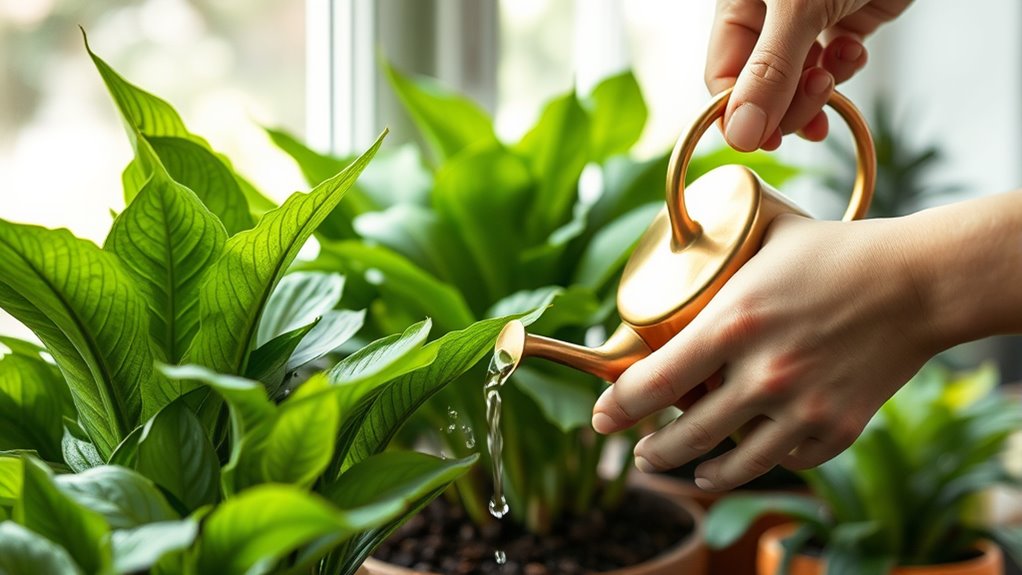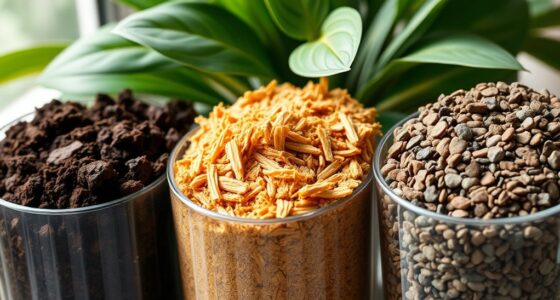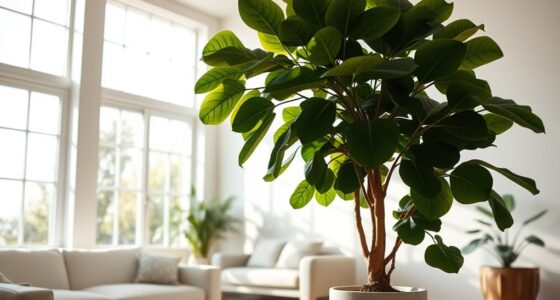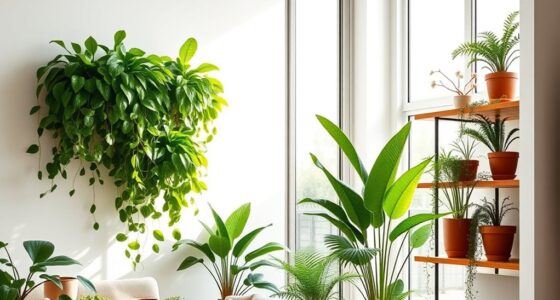To prevent root rot, you should water deeply but infrequently, allowing the soil to dry out slightly between sessions. Use a gentle spray or slow dribble to guarantee even absorption without puddling. Check your soil moisture several inches below the surface before watering again, and avoid overwatering, especially in poorly drained soils. Improving drainage with organic matter or raised beds helps, and maintaining these habits creates healthier plants. Keep exploring for more tips to protect your roots.
Key Takeaways
- Water deeply and infrequently to encourage roots to grow downward and prevent surface waterlogging.
- Check soil moisture before watering to avoid overwatering and maintain proper drainage.
- Use organic amendments like compost or coarse sand to improve soil porosity and drainage.
- Create a slight slope or install drainage features to direct excess water away from plant roots.
- Ensure uniform watering with gentle methods to prevent puddling and reduce soggy soil conditions.
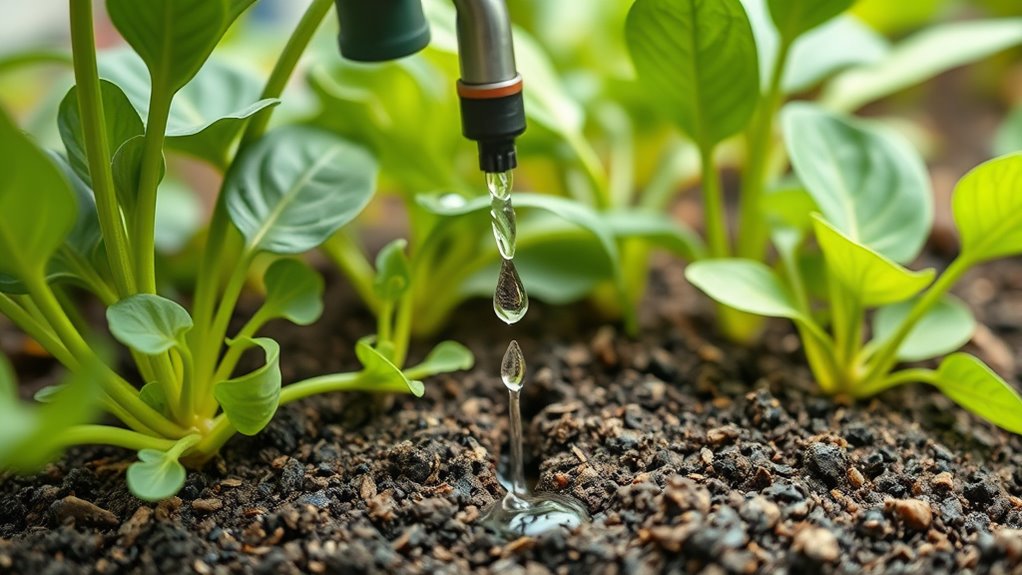
Proper watering is essential for healthy plants, but knowing the right techniques can make a big difference. When you water correctly, you help prevent common issues like root rot, which can quickly kill your plants if left unchecked. One of the key factors in avoiding root rot is ensuring good soil aeration and drainage improvement. Healthy soil isn’t just about providing nutrients; it also needs to allow excess water to escape and air to reach the roots. When soil becomes compacted or poorly drained, water tends to sit around the roots, creating a soggy environment that promotes fungal growth and rotting.
Good soil aeration and drainage are vital to prevent root rot and keep plants healthy.
To improve soil drainage, start by loosening the soil if it’s compacted. You can do this by gently turning the top layer with a garden fork or trowel, which creates more space for water to flow through. If your soil naturally retains a lot of moisture, consider mixing in organic matter like compost or coarse sand. These additions increase porosity, helping water drain more efficiently and enhancing soil aeration. Better aeration allows oxygen to reach the roots, which is fundamental for overall plant health and resistance against root rot.
When you water, aim for deep, infrequent sessions rather than shallow, frequent watering. Deep watering encourages roots to grow downward, making plants more resilient and less prone to rot in the surface layers. Use a watering can or hose with a gentle spray that soaks the soil evenly, avoiding runoff or puddling. Always check the soil’s moisture level before watering again; if it still feels moist a few inches below the surface, hold off until it dries out a bit. This prevents overwatering, which is a primary cause of root rot.
Additionally, consider creating a slight slope around your plants or beds to direct excess water away from the roots. Proper drainage is indispensable—if your garden has poor natural drainage, installing raised beds or adding gravel at the bottom can help improve water flow. These steps prevent water from pooling around the plant’s base, reducing the risk of waterlogged roots. Consistently monitoring your watering habits and adjusting based on weather conditions, soil type, and plant needs will go a long way in preventing root rot and maintaining healthy, vigorous plants. Remember, good soil aeration combined with improved drainage creates the foundation for effective watering, ensuring your plants stay strong and healthy.
Additionally, understanding the role of soil properties in water retention and drainage can help you select the best amendments for your garden.
Frequently Asked Questions
How Can I Identify Early Signs of Root Rot?
You can spot early signs of root rot by checking for overwatering signs like yellowing leaves, wilting, or a musty smell in the soil. Gently remove the plant from its pot to inspect the roots; healthy roots are white and firm, while rotted ones are brown or black and mushy. Poor soil drainage often causes these issues, so improving drainage helps prevent root rot from developing further.
What Are the Best Watering Tools for Preventing Root Rot?
You might find that using a watering can with a narrow spout helps you control water flow, preventing overwatering that causes root rot. Coincidentally, drip irrigation systems deliver steady, precise moisture directly to roots, reducing excess water. Both tools allow you to monitor and adjust watering carefully, ensuring your plants stay healthy and roots remain aerated. Choosing the right method helps you prevent root rot effectively and promotes vigorous growth.
Does Watering Frequency Vary by Plant Type?
Yes, watering schedules vary by plant type to guarantee proper plant hydration. You should adjust how often you water based on each plant’s specific needs, such as light, size, and soil type. For example, succulents need less frequent watering than tropical plants. Pay attention to signs of overwatering or underwatering, and always check soil moisture before watering to prevent root rot and keep your plants healthy.
Can Soil Type Affect Root Rot Risk?
Soil type dramatically influences root rot risk, as it’s the battleground for healthy roots. Your soil composition determines how well it drains and retains water, directly impacting moisture levels. If you don’t consider watering depth, you risk drowning roots in overly saturated soil. Loamy, well-draining soil reduces rot chances, while heavy clay traps moisture. Always match watering depth to soil type to keep roots strong and avoid rot catastrophe.
Are There Natural Remedies to Treat Root Rot?
Yes, you can use natural remedies and organic treatments to treat root rot. For example, remove infected roots and improve drainage, then apply organic fungicides like neem oil or cinnamon powder to the soil. You might also boost plant health with compost tea or beneficial microbes, which help fight pathogens naturally. Always guarantee proper watering practices afterward to prevent future root rot issues.
Conclusion
To keep your plants healthy, remember that overwatering is a common mistake that leads to root rot. Using proper watering techniques, like checking soil moisture and ensuring proper drainage, can make a big difference. Did you know that about 60% of houseplant root rot cases are caused by overwatering? By following these simple tips, you’ll help your plants thrive and stay disease-free. Stay attentive to their needs, and your greenery will thank you!
